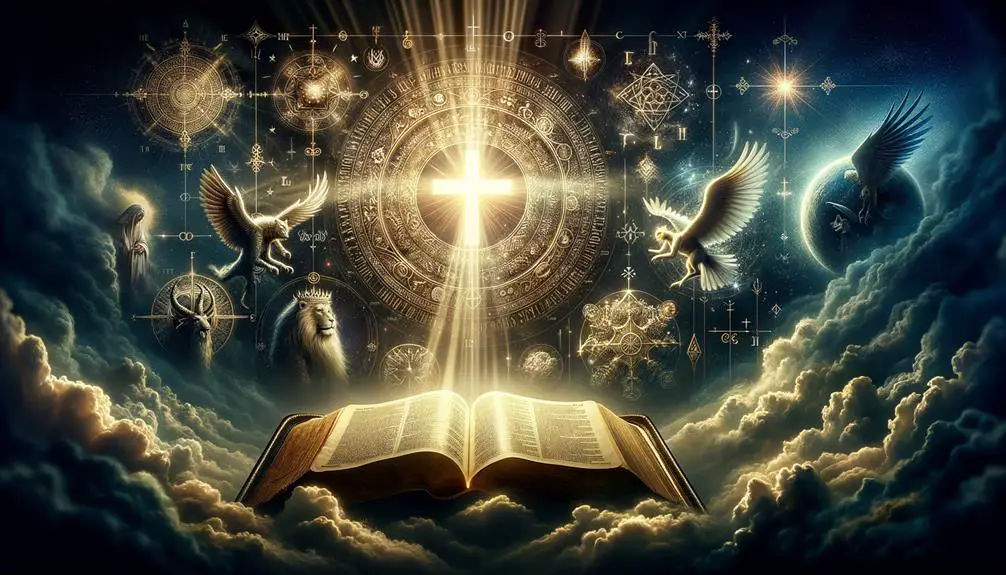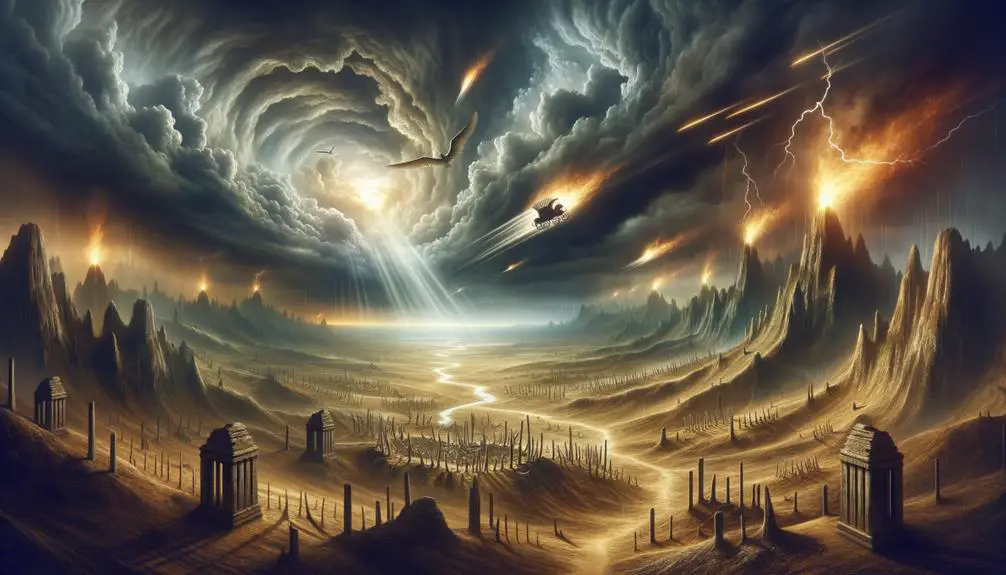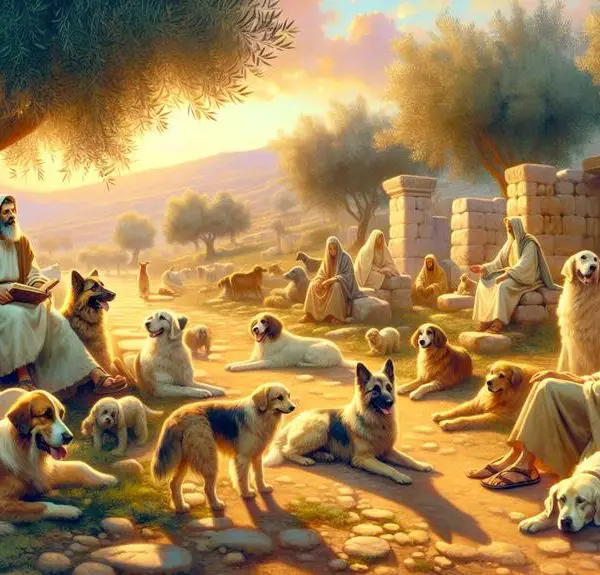Uncover the secrets of end times in the Bible, from Revelation to Daniel, and embark on a journey through prophecy and vision.

Where Does It Talk About End Times in the Bible
Navigating the nuanced narratives of the Bible, you'll find fascinating forecasts of the future. From the vivid visions in the Book of Revelation to the profound prophecies of Daniel, and the insightful instructions in Jesus' Olivet Discourse, these texts tackle the topic of end times with intriguing intricacy.
Whether you're pondering the letters to the Thessalonians, deciphering the prophecies of Isaiah, exploring Ezekiel's end-time visions, or interpreting the parables of Matthew, each scripture segment serves as a signpost to the solemn and sometimes startling events foretold.
As you venture into these verses, you'll uncover layers of meaning that might just reshape your understanding of what lies ahead.
Key Takeaways
- The Book of Revelation details symbolic visions of the end times, including the Seven Seals and the Battle of Armageddon.
- Daniel's prophetic visions, such as the Statue Dream and Vision of Four Beasts, offer insight into God's plan for the end times.
- Jesus' Olivet Discourse provides signs of end times prophecy fulfillment and emphasizes moral vigilance and readiness.
- Paul's Letters to the Thessalonians discuss Christ's return, stressing the importance of ethical living and reassurance about deceased believers' fate.
The Book of Revelation

Within the Christian New Testament, the Book of Revelation stands as a complex and symbolic text that offers a prophetic vision of the end times. You're venturing into a narrative filled with vivid imagery and eschatological symbols that have fascinated and perplexed scholars and believers alike. Central to its discourse on the end times are the Seven Seals and the Armageddon Battle, elements that serve as key prophetic markers in Christian eschatology.
The Seven Seals, as portrayed in Revelation, represent a series of divine judgments that precede the end of the world. Each seal, when broken, initiates a consequential event or series of events that signal the approaching final judgment. These seals encompass various forms of cataclysms, including wars, natural disasters, and divine wrath, each escalating in intensity. The opening of these seals by the Lamb is a pivotal narrative that underscores the sovereignty and justice of the divine in the eschatological process.
Furthermore, the Armageddon Battle, often cited as the ultimate confrontation between good and evil, is depicted as occurring in the end times. This prophetic vision entails a cosmic battle that involves not only earthly nations but also celestial beings. It symbolizes the culmination of human history in a decisive divine intervention, leading to the triumph of good over evil. This battle, steeped in symbolic meaning, underscores the theme of divine justice and the eventual establishment of a new, righteous order.
As you delve into the Book of Revelation, it's clear that its depiction of the end times through the Seven Seals and the Armageddon Battle offers a profound and challenging vision of the world's culmination, emphasizing the themes of divine judgment, redemption, and the ultimate victory of good over evil.
Daniel's Prophetic Visions
You'll find that Daniel's prophetic visions, including the Statue Dream, the Vision of Four Beasts, and the Seventy Weeks Prophecy, offer a complex tableau of end times imagery and symbolism.
These visions are integral to understanding biblical prophecies, as they contribute layers of interpretation to eschatological discussions.
Analyzing these elements reveals insights into the interplay between divine prophecy and human history.
Daniel's Statue Dream
Daniel's Statue Dream, a pivotal moment in biblical prophecy, reveals a multifaceted vision that has intrigued scholars and theologians for centuries. This dream, initially causing Nebuchadnezzar's confusion, demanded an interpretation of significance that only Daniel could provide. The dream's profound implications for future kingdoms and the end times are critical.
- Nebuchadnezzar's confusion: The king was deeply troubled by his dream, unable to understand its meaning without Daniel's intervention.
- Interpretation significance: Daniel's ability to interpret the dream underscores the divine revelation and wisdom given to him.
- Multifaceted vision: The statue, composed of various materials, symbolizes successive empires leading to God's ultimate kingdom.
- Prophetic implications: This vision outlines a historical progression, marking significant shifts in power and the eventual establishment of an everlasting divine kingdom.
Vision of Four Beasts
In his prophetic visions, Daniel encounters a sequence of four beasts, each symbolizing distinct kingdoms that play pivotal roles in the divine narrative of history's progression. These visions, deeply symbolic and rich with metaphor, have been the subject of ancient interpretations, which often viewed them as directly predictive of historical empires and events. Scholars and theologians have painstakingly analyzed the characteristics and timelines associated with each beast, seeking to understand their significance in the broader eschatological framework.
Modern relevance of these visions extends beyond historical curiosity, influencing contemporary theological discussions and interpretations of prophetic literature. The enduring fascination with Daniel's beasts underscores their significance in understanding the complexities of divine prophecy, encouraging a reflective engagement with ancient texts to discern their implications for both past and future events.
Seventy Weeks Prophecy
Building on the mystique of the four beasts, another cornerstone of prophetic literature within the Book of Daniel emerges through the Seventy Weeks Prophecy, offering a complex timeline for pivotal events in salvation history. This prophecy, delivered through Gabriel's message, intricately details the timeline leading up to the Messiah's arrival and beyond.
- Gabriel's message serves as a divine transmission, outlining a prophetic countdown.
- The Seventy Weeks are metaphorically understood, signifying a decreed period for the fulfillment of certain events.
- The prophecy meticulously predicts the Messiah's arrival, linking it to specific historical and future milestones.
- Interpretations vary, but the consensus views this prophecy as a cornerstone in understanding biblical end times and the Messiah's role in salvation history.
Jesus' Olivet Discourse
In Jesus' Olivet Discourse, you encounter a pivotal moment where prophecy and its fulfillment are intricately discussed. His responses to the disciples' queries offer profound insights into the signs that herald the end times.
This segment not only addresses their immediate concerns but also sets a framework for understanding future events in a biblical context.
Prophecy Fulfillment Signs
Jesus' Olivet Discourse unveils critical signs of prophecy fulfillment, directly addressing your understanding of end times. This passage is a cornerstone for identifying the approach of the end times, blending historical context with modern interpretations to provide a comprehensive outlook. Analyzing this discourse offers insight into:
- The emergence of false prophets and deceivers
- Wars and rumors of wars signaling unrest
- Natural disasters as precursors to the end
- The spread of the gospel to all nations
These signs serve as markers, guiding interpretations of current events in light of biblical prophecy. Understanding them requires a balance between acknowledging their historical roots and considering how they might manifest in today's world, making the analysis both a scholarly pursuit and a personal reflection on the times we live in.
Disciples' Queries Addressed
Frequently, disciples approached Jesus with questions about the end times, seeking clarity on the signs and events He'd prophesied. You'll find that in these dialogues, particularly in the Olivet Discourse, Jesus employed apocalyptic symbolism to depict forthcoming tribulations and the ultimate return of the Messiah. This use of vivid, symbolic imagery isn't merely for dramatic effect; it serves to communicate profound truths about the nature of divine judgment and redemption in a way that's accessible yet layered with meaning.
Moreover, these discussions carry significant ethical implications. They're not just about forecasting distant cosmic events but also about urging a moral vigilance and readiness. Jesus' responses to His disciples underscore a call to live righteously, emphasizing that how one lives today is inextricably linked to the ultimate cosmic events foretold.
Letters to the Thessalonians

Paul's letters to the Thessalonians delve into early Christian eschatological views, offering insights into the community's perceptions of the end times. Through his mentorship, Paul addresses the Thessalonian church's concerns and questions about the return of Jesus Christ and the final judgment. His correspondence serves as a foundational text for understanding early Christian expectations and preparations for the end times.
In his letters, Paul emphasizes several key points to the Thessalonian believers:
- The importance of remaining vigilant and morally upright in anticipation of Christ's return. Paul advises the Thessalonians to live lives of holiness and integrity, stressing that the exact timing of these events is unknown and could happen at any moment.
- The concept of the 'Day of the Lord' as a sudden and unexpected event. He introduces this term to describe the Lord's return, highlighting its unpredictability and the need for constant preparedness.
- Reassurance regarding the fate of deceased believers. Paul addresses concerns within the Thessalonian community about the status of those who've died before Christ's return, ensuring them that the dead in Christ will rise first.
- A call to not be easily swayed by false teachings regarding the end times. He warns of the potential for deception and the importance of adhering to the teachings passed down from the apostles.
Paul's guidance to the Thessalonians provides a crucial perspective on early Christian eschatology, reflecting a balance between anticipation of the end times and the necessity for ethical conduct in the present.
The Prophecies of Isaiah
Shifting focus to the Old Testament, the prophecies of Isaiah provide a rich tapestry of insights into the end times, marked by vivid imagery and profound implications for both ancient and contemporary understandings of eschatology. Isaiah's comfort and Messianic predictions stand out as central themes, weaving through the narrative and offering a glimpse into the divine plan for humanity's ultimate redemption.
Isaiah's prophecies are not merely historical; they resonate with timeless themes of hope, justice, and the promise of a new world. These visions offer both consolation and a call to transformation, suggesting that the end times will herald not just an end but a new beginning. The Messianic predictions, in particular, underscore the expectation of a figure who will usher in an era of peace and righteousness.
To help you grasp the complexity and depth of Isaiah's prophecies, here's a table summarizing key aspects:
Aspect |
Description |
Implication |
|---|---|---|
Messianic Predictions |
Foretelling of a Savior |
A central hope for redemption |
Divine Judgment |
Prophesies of accountability |
A call to ethical living |
Renewal of Creation |
Vision of a new heaven and earth |
Promise of cosmic renewal |
Isaiah's Comfort |
Assurance amidst turmoil |
Spiritual and emotional solace |
Universal Peace |
Dream of a world without conflict |
An ideal for human striving |
Isaiah's prophecies, rich in symbolism and steeped in divine mystery, invite you to reflect on the enduring human quest for meaning, redemption, and a future marked by harmony and divine presence.
Ezekiel's End-Time Visions

Ezekiel's end-time visions present a compelling narrative of divine judgment and redemption, inviting you to delve into their profound spiritual and eschatological implications. These visions, rich in symbolism and vivid imagery, offer a glimpse into the culmination of history through the lens of divine intervention and the ultimate restoration of God's people.
- Gog Magog War: Ezekiel chapters 38 and 39 describe a cataclysmic conflict known as the Gog Magog war. This prophetic vision outlines an end-time assault on Israel by a coalition of nations, led by the mysterious figures Gog and Magog. Ezekiel portrays this battle not merely as a geopolitical event but as a pivotal moment in God's redemptive plan, showcasing His power and sovereignty over the nations.
- Cherubim Symbolism: Ezekiel's vision in chapters 1 and 10 introduces the Cherubim, complex creatures representing the presence and glory of God. The symbolism of the Cherubim emphasizes God's holiness and His mobility, indicating His active involvement in human affairs, especially in the context of judgment and redemption.
- Divine Judgment and Restoration: The visions encompass both judgment against Israel's enemies and the promise of restoration for God's people. Ezekiel foresees a time when God will vindicate His name, defeat the forces of evil, and establish His kingdom of peace and righteousness.
- Eschatological Temple: Ezekiel's vision of a future temple in chapters 40-48 signifies the restoration of divine worship and the reestablishment of God's presence among His people, symbolizing hope and renewal in the aftermath of judgment.
Ezekiel's visions offer a multifaceted perspective on the end times, intertwining themes of judgment, restoration, and divine sovereignty, challenging you to reflect on their significance in the broader biblical eschatological narrative.
The Parables of Matthew
Moving from the vivid end-time visions of Ezekiel to the New Testament, the Parables of Matthew offer a unique lens through which to explore Jesus' teachings on the kingdom of heaven and moral conduct. These parables, rich in symbolism and moral lessons, hold profound implications for understanding end times.
One of the central motifs is the lost coin symbolism, illustrating the value of every individual in the eyes of God and the joy in their redemption. This narrative underscores the urgency and importance of repentance and salvation as the kingdom of heaven approaches.
Similarly, the wedding feast analogy encapsulates the theme of preparedness and inclusivity in the kingdom of heaven. It serves as a stark reminder that entry into the kingdom is not guaranteed by mere association or superficial faith but by readiness and genuine commitment to God's call.
To further dissect these teachings, let's examine a comparison of key parables:
Parable |
Symbolism |
Moral Lesson |
|---|---|---|
Lost Coin |
Value of individuals |
Joy in redemption; importance of salvation |
Wedding Feast |
Kingdom's inclusivity |
Need for preparedness; genuine commitment |
Talents |
Use of gifts |
Accountability; using abilities for kingdom work |
These parables, among others in Matthew, provide a nuanced understanding of Jesus' teachings on moral conduct and the nature of the kingdom of heaven. They emphasize the immediacy of repentance, the joy in redemption, and the criteria for entering the kingdom, all of which are essential for comprehending end times from a biblical perspective.
Frequently Asked Questions
How Do Modern Scholars Interpret the Symbolic Language Used in Biblical End Times Prophecies?
Modern scholars approach the symbolic language in biblical prophecies through a lens of symbolic interpretation, dissecting ancient metaphors to understand their meanings in historical and cultural contexts.
You'll find that they often consider these symbols not as literal forecasts but as complex messages tailored to their original audiences.
Their analysis is deeply rooted in historical, linguistic, and cultural studies, aiming to unpack the layers of meaning within the ancient text's symbolic language.
In What Ways Have End Times Interpretations Impacted Historical or Contemporary Political Movements?
End times interpretations have deeply impacted political movements throughout history. For instance, the Crusades were significantly influenced by apocalyptic expectations, driving European powers to reclaim holy lands.
Additionally, the development of Millennialism shaped American political ideologies, particularly with the Puritans, who saw their new society as a beacon for Christ's second coming. These beliefs haven't only motivated actions but also justified political and military endeavors in pursuit of fulfilling prophetic visions.
How Do Different Christian Denominations Vary in Their Understanding and Emphasis on End Times Prophecy?
You'll find that Christian denominations diverge significantly in their understanding and emphasis on end times prophecy, reflecting vast eschatological differences. These variations stem from distinct interpretive traditions, shaping how each group perceives biblical prophecies about the end times.
Some denominations might prioritize literal interpretations, while others lean towards symbolic or allegorical understandings. This diversity in eschatological views influences both the theology and the practices of these various Christian communities.
What Are the Ethical Implications of Preaching About the End Times in a Multi-Faith Society?
When you explore the ethical implications of preaching about the end times in a multi-faith society, it's crucial to engage in respectful interfaith dialogue. Ethical preaching involves acknowledging the diversity of beliefs and avoiding fear-mongering or exclusivity that could alienate or harm others.
It's about fostering understanding and peace, rather than sowing division. You're tasked with navigating these conversations thoughtfully, ensuring they contribute to a cohesive, respectful community dialogue.
How Has Popular Culture, Such as Movies and Literature, Shaped the Public's Perception of Biblical End Times?
You've seen the shadow of a zombie apocalypse and alien invasion cast over society's canvas, haven't you? These images, born from popular culture's cauldron, have deeply colored the public's perception of biblical end times. Through movies and literature, they've not just entertained but also subtly shaped how we interpret these ancient prophecies.
Analyzing this trend, it's clear that what was once sacred text has been morphed into mainstream entertainment, altering collective beliefs and understandings.
Conclusion
In examining biblical references to the end times, it's evident that this theme permeates various books, from Revelation to the Old Testament prophets.
Interestingly, a Pew Research Center survey found that 41% of Americans believe that Jesus Christ will return by 2050. This statistic underscores the enduring impact and relevance of these biblical prophecies in contemporary society.
Analyzing these texts reveals a complex tapestry of visions and teachings that have fascinated scholars and believers alike for centuries.



Sign up